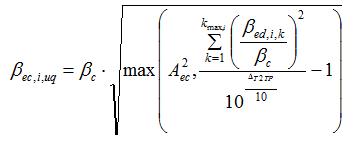1 E-DPCCH Physical Channel
The E-DPDCH is used to carry the E-DCH transport channel. There may be zero, one, or several E-DPDCH on each radio link.
The E-DPCCH is a physical channel used to transmit control information associated with the E-DCH. It is transmitted at the same instant on the radio frame as the E-DPDCH channel carrying data for E-DCH transport channel. The information carried by E-DPCCH
E-DPCCH Power beta_ec
The E-DPDCH is used to carry the E-DCH transport channel. There may be zero, one, or several E-DPDCH on each radio link.
The E-DPCCH is a physical channel used to transmit control information associated with the E-DCH. It is transmitted at the same instant on the radio frame as the E-DPDCH channel carrying data for E-DCH transport channel. The information carried by E-DPCCH
- RSN : Retransmission Sequence Number - Indicates the HARQ transmission number to the network. It is incremented for each re-transmission on the HARQ. The length of RSN is 2 bits, so it wraps around after 3
- Happy Bit : UE indicates if it needs more resources in the UL to transmit pending data by setting this to “Un Happy”. Length is 1 bit.
- E-TFCI : The E-TFCI of the current E-DPDCH transmission.
1.1 E-DPCCH Power Offset
E-DPCCH power level is crucial for proper decoding of the physical channel and subsequent interpretation of E-DPDCH. The power level is specified with respect to that of DPCCH i.e. the ratio E-DPCCH power to DPCCH power called E-DPCCH Power OffsetE-DPCCH Power beta_ec
-------------------------- = -----------
DPCCH Power beta_c
beta_ec is the gain factor for E-DPCCH, and controls the E-DPCCH power
beta_ec is the gain factor for E-DPCCH, and controls the E-DPCCH power
beta_c is the gain factor for DPCCH
E-DPCCH-Info ::= SEQUENCE {
e-DPCCH-DPCCH-PowerOffset E-DPCCH-DPCCH-PowerOffset,
happyBit-DelayCondition HappyBit-DelayCondition
}
The IEs signaled are:
E-DPCCH-Info-r7 ::= SEQUENCE {
e-DPCCH-DPCCH-PowerOffset E-DPCCH-DPCCH-PowerOffset,
happyBit-DelayCondition HappyBit-DelayCondition,
e-TFC-Boost-Info E-TFC-Boost-Info-r7 OPTIONAL,
e-DPDCH-PowerInterpolation E-DPDCH-PowerInterpolation OPTIONAL
}
E-TFC-Boost-Info-r7 ::= SEQUENCE {
e-TFCI-Boost INTEGER (0..127),
delta-T2TP INTEGER (0..6) OPTIONAL
}
The power of E-DPCCH is the same for all transmissions of E-DPDCH and a new RRC reconfiguration message has to be sent if the power has to be increased.
The E-DPCCH gain factor is given by:
2 RRC Signaling
The E-DPCCH Power offset is signaled by the RRC as e-DPCCH-DPCCH-PowerOffset IE in the message to setup the Radio Link.2.1 Rel 6
In Rel6 the RRC could signal a static E-DPCCH/DPCCH power ratio to be used by the UE.E-DPCCH-Info ::= SEQUENCE {
e-DPCCH-DPCCH-PowerOffset E-DPCCH-DPCCH-PowerOffset,
happyBit-DelayCondition HappyBit-DelayCondition
}
2.2 Rel 7
Rel7 provides for E-DPCCH power boosting according to the parameters signaled by the RRC.The IEs signaled are:
E-DPCCH-Info-r7 ::= SEQUENCE {
e-DPCCH-DPCCH-PowerOffset E-DPCCH-DPCCH-PowerOffset,
happyBit-DelayCondition HappyBit-DelayCondition,
e-TFC-Boost-Info E-TFC-Boost-Info-r7 OPTIONAL,
e-DPDCH-PowerInterpolation E-DPDCH-PowerInterpolation OPTIONAL
}
E-TFC-Boost-Info-r7 ::= SEQUENCE {
e-TFCI-Boost INTEGER (0..127),
delta-T2TP INTEGER (0..6) OPTIONAL
}
| IE name | Description |
| e-DPCCH-DPCCH-PowerOffset | Ratio E-DPCCH power to DPCCH power called |
| e-TFCI-Boost | E-TFCI threshold beyond which boosting of E-DPCCH is enabled |
| delta-T2TP | Traffic to Total Pilot power offset |
3 Calculating E-DPCCH Power at UE
3.1 Rel 6
In Rel 6, the E-DPCCH Power in the UL is calculated based on the parameter E-DPCCH Power Offset, which gives the power relative to the DPCCH power.The power of E-DPCCH is the same for all transmissions of E-DPDCH and a new RRC reconfiguration message has to be sent if the power has to be increased.
The E-DPCCH gain factor is given by:
where Aec is the E-DPCCH Power Offset signaled by RRC for that Radio Link.
3.2 Rel 7
In Rel 7 there is provision to boost the power of E-DPCCH automatically when the UL data rate on E-DPDCH is higher. This is acomplished by configuring e-TFCI-Boost. This is the E-TFCI beyond which the E-DPCCH boosting comes into effect. For all E-TFCI below this, the static relation as in Rel 6 above is applied. To control the amount of boosting, there is another parameter delta-T2TP. This is the Traffic to Total Pilot power offset and controls the quantised level of E-DPCCH power chosen according to the following relation:

The above equation is used to calculate the E-DPCCH power level for every transmission. The power level of all the E-DPDCH channels to be used in the upcoming transmission, influence the power of E-DPCCH channel.
Aec is the E-DPCCH power offset
3.2 Rel 7
In Rel 7 there is provision to boost the power of E-DPCCH automatically when the UL data rate on E-DPDCH is higher. This is acomplished by configuring e-TFCI-Boost. This is the E-TFCI beyond which the E-DPCCH boosting comes into effect. For all E-TFCI below this, the static relation as in Rel 6 above is applied. To control the amount of boosting, there is another parameter delta-T2TP. This is the Traffic to Total Pilot power offset and controls the quantised level of E-DPCCH power chosen according to the following relation:
The above equation is used to calculate the E-DPCCH power level for every transmission. The power level of all the E-DPDCH channels to be used in the upcoming transmission, influence the power of E-DPCCH channel.
Aec is the E-DPCCH power offset
beta_edi,k is the E-DPDCH gain factor for the i:th E-TFC on the k:th physical channel
kmax,i is the number of physical channels used for the i:th E-TFC.
It can be followed from the above equation that the E-DPCCH power is always greater than or equal to that give by the static relation of Rel 6. Higher value of delta-T2TP means the traffic channel is stronger and as a result the E-DPCCH power will be lower.
kmax,i is the number of physical channels used for the i:th E-TFC.
It can be followed from the above equation that the E-DPCCH power is always greater than or equal to that give by the static relation of Rel 6. Higher value of delta-T2TP means the traffic channel is stronger and as a result the E-DPCCH power will be lower.
